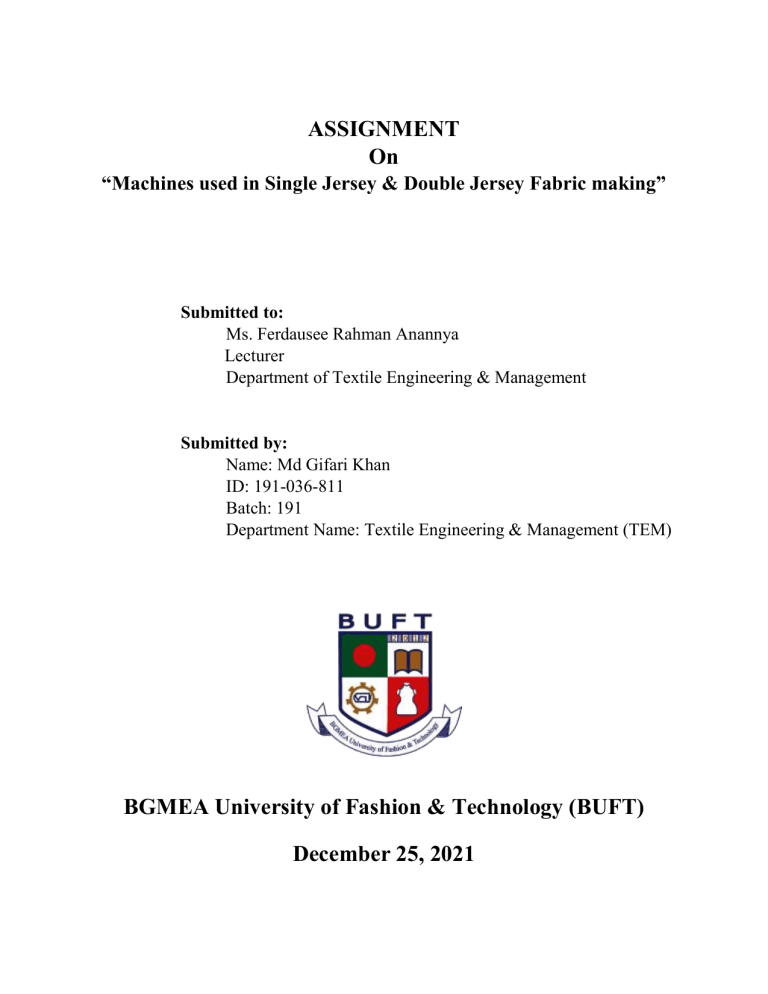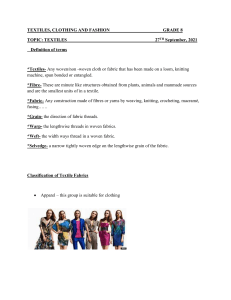
ASSIGNMENT On “Machines used in Single Jersey & Double Jersey Fabric making” Submitted to: Ms. Ferdausee Rahman Anannya Lecturer Department of Textile Engineering & Management Submitted by: Name: Md Gifari Khan ID: 191-036-811 Batch: 191 Department Name: Textile Engineering & Management (TEM) BGMEA University of Fashion & Technology (BUFT) December 25, 2021 Single Jersey Circular Knitting Machine: Circular knitting machine is widely used throughout the knitting industry to the produce fabric. This machine can be built in almost any reasonable diameter and the small diameter of up to five, which are used for wear. Machine for outerwear and under wear may vary from 12 inch to 60 inch in diameter according to manufactures requirement. This machine can be used either as fabric or for making garments completely with fancy stitch. Latch needles are commonly employed in all modern circular machines because of their simple action and also their ability to process more types of yarns. Key features of single jersey circular knitting m/c or plain circular latch needle m/c has presented in the below: 1. The machine has only one bed which may be flat or circular. 2. There is only one set of needles and one cam system in the machine. 3. Minimum one yarn is needed to produce a fabric. 4. Single faced structure, i.e. only one type of loops- face or back are visible on the surface. 5. Loops are V-shaped on the technical face and semi-circular on technical back of the fabric. 6. Because of side limbs of the loops on the face side, it feels smoother on the face side than the backside. Single jersey circular knitting machine 7. Knitted loops tend to distort easily under tension which helps to five form-fitting and comfortable. 8. Fabric shortens in width if the same is extended in length by tension and vice-versa. 9. The fabric has good extensibility in both length and width direction but width-wise extensibility is generally much higher than lengthwise extensibility. 10. Yarn/course can be unroved from starting and ending end of knitting 11. Fabric curls at the free edges on flat surface-toward the front at the upper and lower edges and toward the back at left and right edges. This curling is mainly due to the unbalanced yarn bending moment existing in the three-dimensional nature of the structure. Yarn bending rigidity property is responsible for curling. Single Jersey Structure 12. Because of stitch simplicity, the production rate is high and the machine is simple and cheap. 13. Stitch length can be varied with stitch cam setting. 14. Fabric shrinks in width/circumference and the extend of shrinkage is about in the range of 25-40%. 15. Course per inch and wales per inch in the fabric inversely varies with loop length. 16. Properties like rigidity, air permeability, bursting strength etc and GSM of the fabric change with change in loop length. 17. Laddering takes place; laddering means disintegration of loops due to breakage of yarn as the intermeshed loops are held by each other at the cross-over points. The needle loops preferably unmesh down the wale. 18. Fabric thickness is approximately two times the diameter of the yarn used. Laddering Effect 19. Sinker top machine is very common. 20. Common gauge is 16-28 for circular machines and 5-12 for flat machines. Circular Rib Knitting Machine: On a double knitting machine, the needles are “gaited” — the needles in the dial and the cylinder are spaced in relationship to each other. With rib gaiting, the two sets of needles are not directly opposite each other, but are staggered. This means that the needles can be used at the same time. The first rib frame was invented by Jedediah Strutt of Derby in 1755, which used a second set of needles to pick up and knit the sinker loops of the first set. It is now normally knitted with two sets of latch needles. 1 X 1 rib is production of by two sets of needles being alternately set or gated between each other. Features of Circular Rib Knitting Machine Used in Textile Sector: 1. Machine has two beds- may be flat or circular. 2. There are two sets of needles- one in each bed. 3. There are two cam systems- one in each bed. 4. Needles in the two beds are not face to face but needles in one bed are in between the needles of the other bed so that they do not touch while raised for clearing. Circular rib knitting machine 5. Rib fabrics are double-faced structures as well as balanced structures. 6. Both face loops and back loops are visible on both sides of the fabric and fabric has an identical appearance in face and back. 7. Each course is made of the face loop and back loop in an alternative order. 8. Face loops are made by the needles in front bed/ cylinder bed and back loops are made by needles in the back bed/ dial bed. 9. Fabric surface is vertically corrugated or ribbed. 10. Fabric is much thicker, generally double than single jersey fabric. 11. Fabric has good extensibility in the length direction, but the widthwise extensibility and the recovery are much higher than single jersey fabric which makes it suitable for neck collar, cuff, waistband etc. 12. Fabric surface is rough or harsh in feel. 13. Fabric does not curl at the free edges. 14. Fabric can easily be unroved from the end last knitted. 15. Loop length can be changed by varying dial height or vertical gap between two beds and timing of knitting in addition to stitch cam setting in both the beds. 16. Rib machines require finer yarn and result in comparatively costly fabric. 17. Simplest needle gaiting is 1 x 1 but other combinations like 2 x 2, 3 x 3, 6 x 3 etc. are also possible. 18. Minimum one yarn is needed to produce a fabric. Purl Circular Knitting Machine: Double cylinder purls circular knitting machine makes purl structure fabric which have one or more wales which contain both face and reverse loops. This can be achieved with double-ended latch needles or by rib loop transfer from one bed to the other, combined with needle bed racking.The semi-circles of the needle and sinker loops produced by the reverse loop intermeshing tend to be prominent on both sides of the structure and this has led to the terms" links-links" being generally applied to purl fabrics and machines. Purl Circular Knitting Machine Features of Purl Knitting Machine: 1. Machine has two beds. Machine may be flat or circular. 2. There is only one set of needles which change the bed in alternatively knitting cycle. 3. Needles are of a special type; generally double hooked latch needles are used. 4. Needles are shifted from one bed to another bed with the help of sliders. Two sliders are needed for each needle. 5. Same needle makes face loop in one bed a back loop in other bed. Purl structure and necessary elements 6. Alternative courses are made of all face loops and all back loops. As a result each wale is made of face loop and back loop in an alternative order. 7. Fabric has horizontal corrugation or rib appearance on the surfaces, i.e. opposite to rib fabric. 8. Fabric is reversible in appearance and has a soft handle. 9. Fabric has very high extensibility in the length direction, making it suitable for kidswear. 10. Fabric does not curl at the edges because of the alternate face and back loop courses. 11. The knitting sequence or needle gaiting can be changed to produce rib and plain structures on one hand and derivatives like moss purl, basket purl etc on the other. Interlock Circular Knitting Machine: There is four basic knitted structure required different types of machine to produce them. The plain structure can be produce by single jersey circular knitting machine, where the cylinder with needle revolves on the stationary cam. The rib and interlock structure are required two sets of needles arranged in horizontally and vertically. The horizontal needles places on the groove of dial and the vertical needles grooved on the cylinder. Both cylinder and dial needles circulated around the stationary cam. Another type is purl structure, required special types of m/c and needles. Features of Interlock Knitting Machine: 1. Machine has two beds, machine may be flat or circular but generally circular. 2. There are two subsets of needles in each bed, the subsets re known as short and long needles respectively. 3. Two sets of cam system, i.e. cam path in each bed accommodate short and long needles in the other bed and vice-versa. 4. Short needles in one bed make loops in conjunction with short needles in the other bed. Similarly, long needles in one bed make loops in conjunction with long needles in the other bed. Interlock fabric structure 5. Separate yarns are to be supplied to the short needles and long needles for loop formation through separate feeders. 6. Short needles and long needles don’t make loop simultaneously but with a time gap. 7. Loops made by one set of needles are locked by the loops made by the other set of needles. 8. Each interlock course is composed of two rib courses. 9. Minimum two yarns are needed to produce a fabric. 10. Fabric has a double face as well as a stable structure. Interlock Circular Knitting Machine 11. Fabric surface is smooth. 12. Fabric is equally thicker to rib but much more compact. 13. Fabric neither curls nor ladders. 14. Like a rib, an interlock can be made of a different combination of needle gaiting. 15. Interlock fabric made from 2x2 needle gaiting or 2x2 rib is known as eight lock fabric, as there are total eight loops in a unit of interlock loop. 16. Machine is complicated and costly. 17. Fabric are dimensionally stable, heavy and costly.



